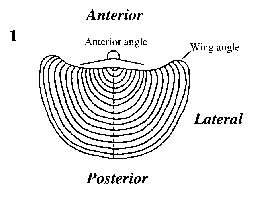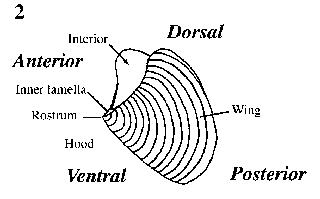Morphological Terminology
The terms describing the various forms of these fossil structures are complicated and somewhat confused. Many of the terms, originally defined as morphological features, have subsequently been adopted as taxonomic names. Further, a number of names of taxa have since been considered as morphological terms. It seems clearest to use the simple set of terms proposed by Moore and Sylvester-Bradley (1957a) in the Treatise on Invertebrate Paleontology. Aptychus (plural: aptychi) is considered a general name for this group of fossil cephalopod fragments, although it has a restricted meaning as the group of bivalved forms. Anaptychus is used to refer to the univalved structures found alone or in association with the pair of aptychi sensu stricto in younger rocks. For general discussion, these terms are useful:
"aptychus [broad sense] -- All types of calcareous or corneous structures presumed to serve as opercula [or mandibles] of ammonoid conchs.
diaptychus [= aptychus sensu stricto] -- Aptychus composed of two discrete valves.
anaptychus -- Univalved type of aptychus." (terms modified from Moore and Sylvester-Bradley, 1957a)
With the multiplicity of interpretations, published descriptions of aptychi and similar specimens are hard to reconcile. The life orientation of these fossil fragments is necessarily different if they are arthropod carapaces (Clarke, 1882; Ruedemann, 1916), brachiopods (Clarke, 1902), cephalopod mandibles (Lehmann, 1970), or opercula (Trauth, 1927; Turek, 1978).
The orientation of these structures would be the same whether they were interpreted as crustacean carapaces or cephalopod mandibles. In each case, the rostrum or apex (center of the concentric ornamentation) is anterior; the hinged region is medial. For detailed terminology, see Figure 1. The morphological terms used here are based on those defined by Clarke (1962) for the description of coleoid cephalopod mandibles. The anterior angle is here defined as the angle of the anterior margin of the flattened fossil; convex if the rostrum is emergent, concave if it is reentrant.


Figure 1. Stylized diagrams of an early cephalopod lower mandible, showing reference attitude and morphological terms. Terminology after Clarke (1962). 1, Ventral view, extended and flattened. 2, Exterior lateral (oblique) view.
Should it prove correct that aptychopsid plates were nautiloid opercula (Holland, et al., 1978; Turek, 1978) whereas aptychi proper served as ammonite mandibles (Lehmann, 1970), then new terminology would have to be created for the former. Not only would the function be different, but the two structures, otherwise similar in appearance, would have had opposite orientations in the living animals.